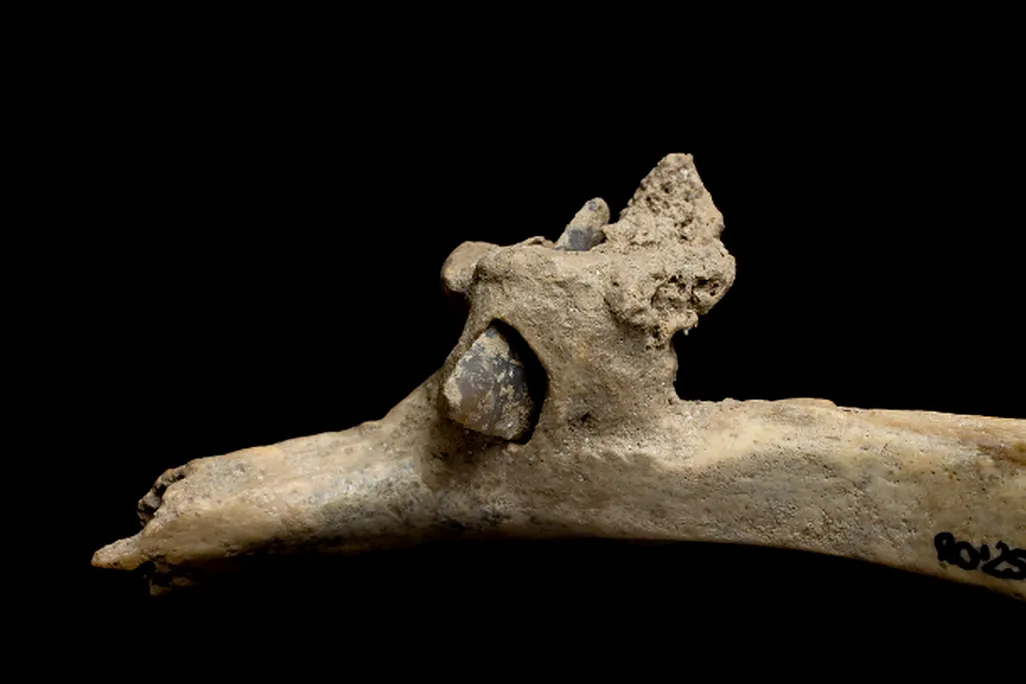An Archer Shot This Bronze Age Human in the Back. 4,000 Years Later, the Arrow Is Still Embedded in the Victim’s Rib Bone
The attack took place during a period of conflict between groups living in the Pyrenees mountains in modern-day Spain

Some 4,000 years ago, an archer in the Pyrenees mountain range fired a flint arrowhead at another person, advancing on them from behind. The projectile struck the victim’s back but didn’t immediately kill them.
A recent analysis of the arrowhead, which is still embedded in the individual’s rib bone, suggests the attack unfolded during a period of “interpersonal conflict” between warring clans in what is now northeastern Spain, notes a statement from the Catalan Institute of Human Paleoecology and Social Evolution (IPHES). The bone shows signs of healing, indicating the victim survived for some time after receiving the injury.
The rib was found during excavations at the Roc de les Orenetes, a high-altitude cave in Queralbs, Spain, that served as a burial site during the early Bronze Age. So far, archaeologists have recovered more than 6,000 skeletal remains from the cave, some of them bearing signs of violence, such as cut marks from axes and daggers.
Roc de les Orenetes (Queralbs, Pirineu català) | Fa 4.500 anys: un individu ferit amb una fletxa a l’esquena que va sobreviure un temps
— IPHES-CERCA (@iphes) July 8, 2025
Evidència directa de violència prehistòrica a 1.800 metres d’alçada
Més info: https://t.co/sC6VjGgbVW pic.twitter.com/uRjSIbmxzq
The newly unearthed arrowhead adds to the growing body of evidence that the Roc de les Orenetes community engaged in violent confrontations with other groups, perhaps over “social, resource-based or territorial disputes,” as the researchers wrote in a 2024 study published in the American Journal of Biological Anthropology.
“This extraordinary discovery is direct proof, and confirms our initial hypothesis,” Carlos Tornero, an archaeologist at IPHES and the Autonomous University of Barcelona who led the excavations, tells National Geographic’s Tom Metcalfe.
Per the statement, earlier excavations had revealed arrowheads at the cave site, but archaeologists were unsure whether these weapons were funerary goods or projectiles responsible for fatal injuries.
Miguel Ángel Moreno-Ibáñez, an archaeologist at the University of Edinburgh in Scotland, led the analysis of the rib fragment. Previously, for the 2024 study, he analyzed skeletal remains discovered at the Roc de les Orenetes, identifying evidence of perimortem trauma (sustained around the time of death) in at least 6 of the 51 individuals analyzed.
These injuries pointed to “more than one episode of interpersonal violence” taking place over the period when the cave was used as a burial site, the study’s authors wrote. The victims of this violence were likely members of a single clan of early Bronze Age farmers, while their attackers may have been nomadic hunters, Tornero tells National Geographic.
Excavations at the Roc de les Orenetes, which was discovered by a local in 1969, are ongoing. The rib fragment is currently being analyzed with X-ray microtomography, and additional chemical and genomic studies are expected to follow.
“Now we can study the force of the impact, the type of weapon used, and the position of the attacker and the victim,” Moreno-Ibáñez says in the statement.

